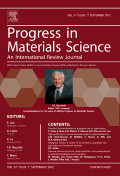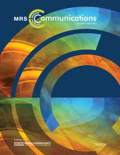
ACS Materials Letters
Scope & Guideline
Innovative Insights for Tomorrow's Technologies
Introduction
Aims and Scopes
- Advanced Materials Synthesis and Characterization:
Research involving novel methods for synthesizing materials, including nanomaterials, thin films, and composites, and their characterization using advanced techniques. - Materials for Energy Applications:
Studies on materials designed for energy conversion and storage, including batteries, fuel cells, and solar cells, focusing on enhancing performance and stability. - Functional and Smart Materials:
Exploration of materials with unique properties that respond to external stimuli, including stimuli-responsive polymers, hydrogels, and nanocomposites. - Biomaterials and Biomedical Applications:
Research on materials designed for medical applications, including drug delivery systems, bioactive scaffolds, and diagnostic tools. - Environmental Materials and Sustainability:
Development of materials aimed at addressing environmental challenges, including waste remediation, carbon capture, and sustainable manufacturing processes. - Machine Learning and Computational Materials Science:
Utilization of machine learning and computational methods to predict materials properties and performance, facilitating the design and discovery of new materials.
Trending and Emerging
- Nanomaterials and Nanocomposites:
There is a growing emphasis on the synthesis and application of nanomaterials and nanocomposites due to their enhanced properties and potential in various fields including electronics and biomedicine. - Sustainable and Green Materials:
Research is trending towards developing sustainable materials and processes, focusing on reducing environmental impact and improving recyclability. - Smart and Responsive Materials:
An increase in studies on materials that can change their properties in response to external stimuli, such as temperature, pH, or light, reflecting the demand for smart materials in various applications. - Data-Driven Materials Science:
The application of machine learning and data analytics to accelerate materials discovery and optimization is emerging as a significant trend, indicating a shift towards computational approaches in materials research. - Energy-Efficient Technologies:
Research on materials aimed at improving the efficiency of energy conversion and storage technologies, such as advanced battery materials and photocatalysts, is increasingly prominent.
Declining or Waning
- Traditional Bulk Material Research:
There has been a noticeable decline in studies focused on traditional bulk materials, as the field shifts towards nanostructured and hybrid materials that offer enhanced functionality. - Conventional Coatings and Surface Treatments:
Research on conventional coatings and surface treatments is becoming less frequent as more innovative and multifunctional materials gain traction. - Low-Dimensional Materials for Basic Applications:
The focus on low-dimensional materials purely for fundamental studies is waning, as interest grows in their practical applications and integration into devices.
Similar Journals

PROGRESS IN MATERIALS SCIENCE
Driving Progress in Material TechnologiesPROGRESS IN MATERIALS SCIENCE is an esteemed peer-reviewed journal published by Pergamon-Elsevier Science Ltd, focusing on pioneering advancements and comprehensive studies in the field of Materials Science. With an ISSN of 0079-6425 and an E-ISSN of 1873-2208, this journal boasts a prestigious status, ranking in the Q1 category for Materials Science (miscellaneous) and achieving a remarkable 99th percentile in Scopus rankings, positioned 4th out of 463 journals in General Materials Science. Published from the United Kingdom, PROGRESS IN MATERIALS SCIENCE provides critical insights into the latest discoveries, trends, and methodologies shaping the materials science landscape, making it an invaluable resource for researchers, professionals, and students alike. Readers can explore rich content on subjects ranging from nanomaterials to biomaterials and beyond, all designed to foster innovation and knowledge dissemination in the materials science community. Although it is not an open-access journal, it remains a pivotal platform for high-quality research and essential discourse in this dynamic field.

Advanced Materials Interfaces
Fostering Collaboration in Materials Engineering ExcellenceAdvanced Materials Interfaces is a premier journal dedicated to the exploration and advancement of materials science, with particular emphasis on the interfacial phenomena that govern the behavior of materials in various engineering applications. Published by WILEY in the United Kingdom, this Open Access journal, established in 2014, has quickly ascended to a Q1 category ranking in both Mechanical Engineering and Mechanics of Materials as of 2023, reflecting its significant influence and excellence in the field. With impressive Scopus Ranks, such as #81 out of 672 in Mechanical Engineering and #58 out of 398 in Mechanics of Materials, it serves as a vital resource for researchers and practitioners aiming to push the boundaries of materials innovation. The journal provides unrestricted access to its cutting-edge research, promoting collaboration and dissemination of knowledge among the global scientific community, solidifying its role as a vital contributor to the ever-evolving landscape of materials engineering.

Small Science
Advancing the Frontiers of Catalysis and Materials ScienceSmall Science is an esteemed open-access journal published by WILEY, dedicated to pioneering research in the realms of catalysis, materials science, and chemical engineering. Established in 2021, this journal has rapidly gained recognition, ranking in the top quartiles (Q1) in various categories, including a remarkable 17th position in Materials Science and 8th in Chemical Engineering on Scopus. With an impact factor reflective of its growing influence and a commitment to disseminating cutting-edge knowledge, Small Science serves as a crucial platform for researchers, professionals, and students seeking to explore the latest advancements and applications in these dynamic fields. The journal's open-access model ensures wide reach and accessibility, facilitating collaboration and innovation across disciplines. Its headquarters are located in the United States, at 111 River St, Hoboken, NJ, supporting a global readership keen on addressing contemporary scientific challenges and driving progress in technology and materials synthesis.

Advanced Materials Technologies
Catalyzing Breakthroughs in Advanced MaterialsAdvanced Materials Technologies is a leading scholarly journal published by WILEY, dedicated to the rapidly evolving fields of materials science and engineering. With an impressive 2023 impact factor reflected in its Q1 ranking in Industrial and Manufacturing Engineering, Mechanics of Materials, and a notable position within the materials science community, this journal stands as a premier platform for disseminating innovative research and technological advances. The journal encompasses a diverse range of topics, from the fabrication and characterization of advanced materials to their applications in various industries, thus fostering interdisciplinary collaboration among researchers, professionals, and students. Since its inception in 2016 and looking forward to 2024, Advanced Materials Technologies continues to provide unparalleled access to high-quality, peer-reviewed articles, ensuring that it remains a vital resource for anyone involved in the design and optimization of advanced materials.

Accounts of Materials Research
Empowering researchers with cutting-edge insights.Accounts of Materials Research is a premier journal published by the American Chemical Society, focusing on the multidimensional field of materials science. With a robust impact factor and a commitment to open-access research, it serves as a vital platform for leading-edge discoveries from 2020 to 2024. The journal has rapidly ascended to the top quartile in multiple categories, including Chemical Engineering, Materials Chemistry, and Polymers and Plastics, demonstrating its significant influence within the academic community. Recognized by Scopus as a key resource—with remarkable rankings that place it in the 95th percentile of its field—Accounts of Materials Research is devoted to publishing high-quality, innovative research that addresses critical challenges in materials development and implementation. This journal is essential for researchers, professionals, and students seeking to stay informed about the latest advancements and collaborative opportunities within the interdisciplinary landscape of materials science.

Frontiers of Materials Science
Unveiling Cutting-Edge Research in Materials ScienceFrontiers of Materials Science is a groundbreaking journal dedicated to exploring advanced materials and their applications within the ever-evolving landscape of materials science. Published by HIGHER EDUCATION PRESS, this journal offers a crucial platform for scholars and practitioners seeking to disseminate innovative research findings that foster interdisciplinary collaboration. Since its inception in 2011, the journal has enjoyed a notable Q2 ranking in the category of Materials Science (miscellaneous) as of 2023, positioning it among the noteworthy publications in the field with a Scopus rank of #222 out of 463. While predominantly published in China, the journal is committed to open access principles, allowing global accessibility to cutting-edge research. With its comprehensive coverage spanning materials synthesis, characterization, properties, and applications, Frontiers of Materials Science not only serves as a repository for academia but also bridges the gap between research and industry, making it an indispensable resource for researchers, professionals, and students alike.

MACROMOLECULAR MATERIALS AND ENGINEERING
Leading the Charge in Open-access Macromolecular ResearchMACROMOLECULAR MATERIALS AND ENGINEERING, published by Wiley-VCH Verlag GmbH, is a distinguished open-access journal that since its inception in 1989 has been at the forefront of research in the fields of Chemical Engineering, Materials Chemistry, and Polymer Science. Recognized with a top-tier Q1 ranking in multiple categories for 2023, including Chemical Engineering and Organic Chemistry, this journal facilitates cutting-edge discoveries and advancements by providing a platform for authors to share innovative findings. With an impressive Scopus ranking, positioned within the top percentiles in several interdisciplinary categories, MACROMOLECULAR MATERIALS AND ENGINEERING is an essential resource for researchers, professionals, and students who are engaged in the development and application of macromolecular materials. As an open-access journal since 2023, it enhances accessibility and fosters collaboration within the global scientific community. The journal, headquartered in Germany, aims to publish high-quality, peer-reviewed articles that drive the scientific dialogue forward in the rapidly evolving fields of materials science and engineering.

MRS Communications
Connecting disciplines for groundbreaking materials research.MRS Communications is a prominent academic journal published by Springer Heidelberg, focusing on the multidisciplinary field of materials science. With ISSN 2159-6859 and E-ISSN 2159-6867, this journal has been a valuable platform for disseminating cutting-edge research since its inception in 2011. Operating from its esteemed headquarters in Heidelberg, Germany, it aims to foster collaboration and innovation among researchers and practitioners by publishing high-quality, peer-reviewed articles. Holding a Q3 ranking in the Materials Science (Miscellaneous) category, and currently positioned at the 37th percentile in the general materials science field, MRS Communications is dedicated to advancing the understanding of materials through interdisciplinary studies. The journal offers researchers an opportunity to share insights that bridge theoretical knowledge with practical applications, contributing significantly to the global materials science community. As an essential resource for researchers, professionals, and students alike, we invite you to explore the latest advancements and discussions in materials science through this influential publication.

Applied Materials Today
Connecting Ideas, Inspiring Discoveries.Applied Materials Today is a leading peer-reviewed journal published by ELSEVIER, dedicated to the field of materials science. With an impressive impact factor and ranked in the Q1 category for materials science (miscellaneous) in 2023, this journal stands out as a crucial platform for sharing groundbreaking research and innovative applications of materials. Based in the Netherlands, the journal has rapidly gained recognition, achieving a remarkable Scopus ranking of 41 out of 463, placing it in the 91st percentile among general materials science publications. Covering a broad range of topics, from the synthesis and characterization of materials to their practical applications, Applied Materials Today seeks to inspire and inform researchers, professionals, and students alike. Its commitment to disseminating high-quality, open-access content ensures that cutting-edge discoveries in materials science can be shared with a global audience, fostering collaboration and advancements in the field.

Interdisciplinary Materials
Advancing the Frontiers of Materials ScienceInterdisciplinary Materials is a prominent Open Access journal published by Wiley, dedicated to advancing knowledge and innovation in the field of materials science. With an ISSN of 2767-4401 and an E-ISSN of 2767-441X, this journal seeks to foster interdisciplinary collaborations and promote high-quality research that bridges the gap between materials engineering, physics, chemistry, and emerging technologies. Established in 2022, it aims to provide free and unrestricted access to cutting-edge research findings, ensuring that pivotal discoveries reach a broad audience. Interdisciplinary Materials assesses submissions rigorously, aspiring to achieve high impact and relevance, catering to researchers, professionals, and students keen on exploring innovative materials and their applications. With its commitment to scientific excellence, this journal stands as a vital resource for those looking to stay abreast of the latest advancements in materials research.